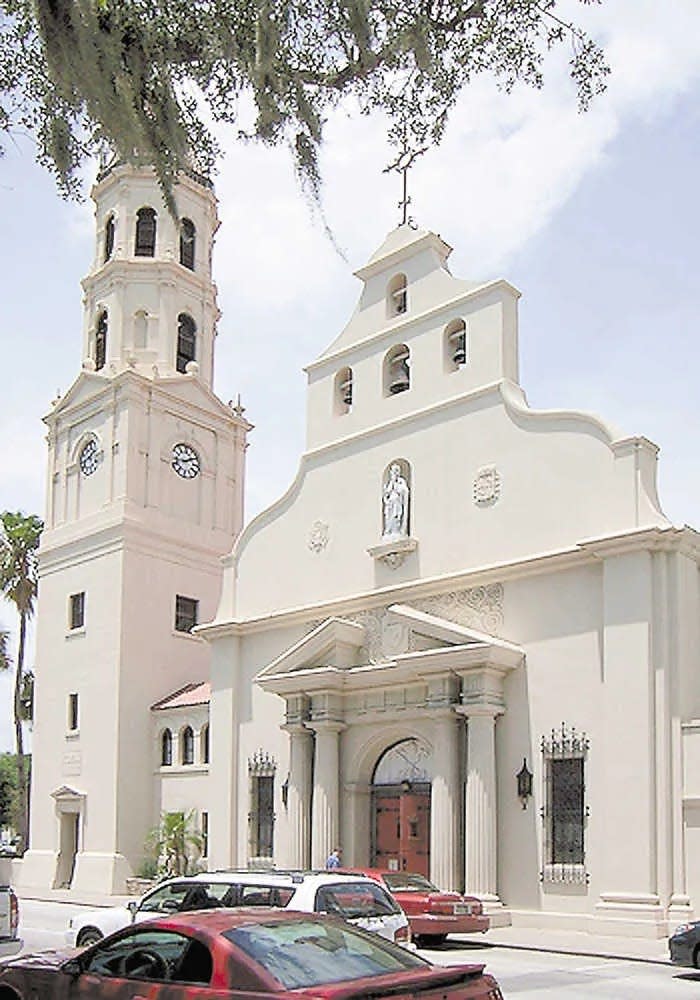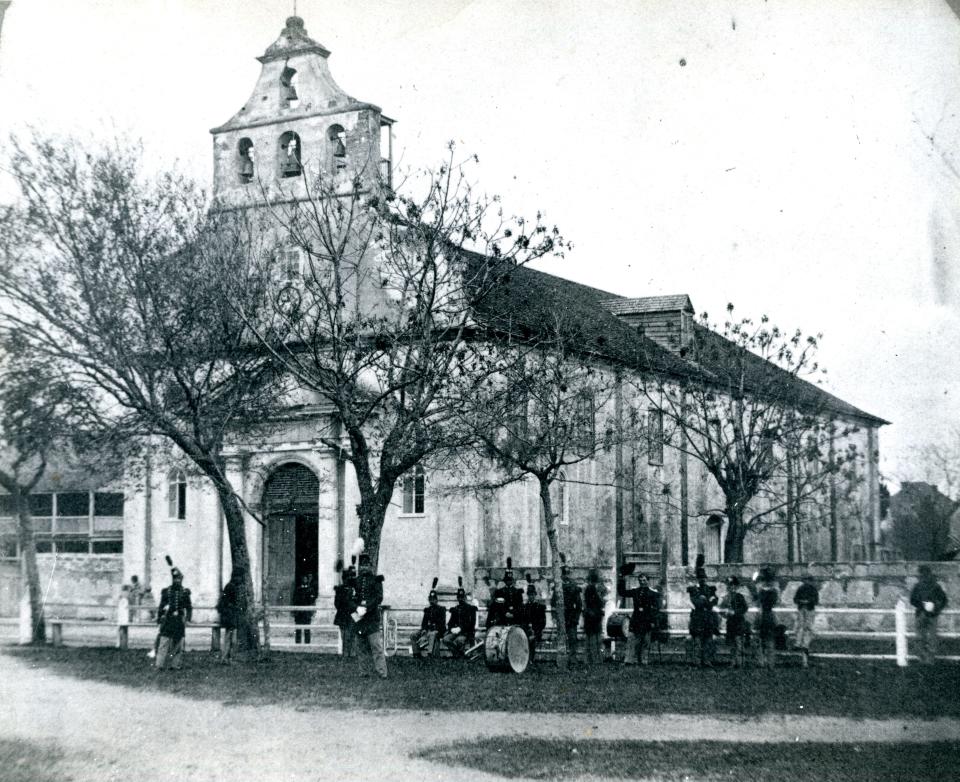Cathedral Basilica of St. Augustine: New USA entry point for Spain’s famed Camino de Santiago
- Oops!Something went wrong.Please try again later.
A decade in the making, the Cathedral Basilica of St. Augustine and the city will be the official U.S.A. starting point this fall for Spain’s centuries-old Camino de Santiago (The Way of St. James).
A celebration of Camino U.S.A. will take place in October, according to Very Rev. John Tetlow, Cathedral Basilica rector/pastor.
“The Camino in the U.S.A. will give continuity to the evangelization by the Apostle Santiago (as St. James the Great is known in Spain),” Tetlow said. “Thanks to modern transportation and technology, the Camino will be able to extend its reach through American paths.”

Susan Parker: Through humble beginnings, the Cathedral Basilica of St. Augustine has endured
Bishop Erik T. Pohlmeier: Cathedral Basilica of Saint Augustine welcomes 11th bishop since 1870
An already visible part of the new designation is the statue of St. James the Great by Spanish artist Juan Vega, which was installed in July in the sanctuary. This statue replicates the one in the Portico de la Gloria in the Cathedral of Santiago de Compostela. The statue will be moved in 2023 to a shrine in the Cathedral Basilica’s west courtyard.
“Most important of all, the new image of St. James is an invitation to take some time alone with God, go on a pilgrimage, maybe not necessarily the Camino itself, but certainly to spend some special time with God to think, to reflect, to pray,” Tetlow said.
The statue was funded with contributions from Nauta Instituto, Malaga, Spain, and the Beaches Fine Arts Series, located in Jacksonville Beach.
Tetlow said details are being worked out among church and city leaders regarding the Camino passport and stamp that will be given to pilgrims beginning their Camino here. The plan is for pilgrims to complete a special route into the city ending at the Cathedral Basilica as their official start before they join a Camino route in Spain, Portugal or France. All Camino routes end at the tomb of St. James the Great in the Cathedral of Santiago de Compostela.
Camino quest was city’s 450th goal for 2015
The quest for Camino U.S.A. began in 2012 by city officials, the Cathedral Basilica and the Diocese.
City Manager John Regan credits Francisco S. Guitard, Madrid, founder and executive director of the NAUTA Instituto, and chief innovation officer, Edriel Inteligence, a tech company, with Camino U.S.A. ideas as a 450th anniversary goal. Regan then advised then-Mayor Joe Boles, Very Rev. Thomas Willis, then-Cathedral rector/pastor, and Bishop Felipe Estevez, then-leader of the Diocese of St. Augustine. They thought it would be ready the 2015 celebration. “These things take time much more than we can ever imagine,” Regan said.
Approval in concert was granted in 2018 by Spain’s Alliance of Cathedrals on the Camino. Regan and Guitard met with Rev. Manuel Perez Moya, dean of the Cathedral of Cordóba, who was in charge of the process. He gave Regan an official letter, sealed with wax, to hand-deliver to Estevez.
“There was utmost discretion with that letter,” Regan said. At that time, Moya advised them that, “We don’t talk about these things until they’re done.”
There were no public discussions or disclosures of the Camino until July. Official recognition by Spain’s Alliance of Deans of Cathedrals on the Camino came last July at a ceremony in the Cathedral of Santiago de Compostela, the Camino’s ending point. Spain’s other cathedrals on the Camino are in Madrid; Avilés, St. Augustine’s Sister City; Cordóba; and Segovia.
Camino U.S.A. finally a reality
With all processes finally worked out, Tetlow led the official delegation to Spain in July, including leaders of the Diocese, the Cathedral Basilica, city government and representatives of academic, cultural and historical sectors.
The Cathedral Basilica was formally welcomed into the alliance and Camino U.S.A. was established. St. Augustine will also be the connector in America for the Camino de Mestizaje, a network of trails connecting Santiago de Chile with Santiago de Compostela, Tetlow said.
“The Camino is, at its very essence, a pilgrimage, an invitation to each of us, according to our ability to walk alone with God,” Tetlow said. “It is far more than a ‘hike’ or ‘trek.’”
New St. James Shrine Camino USA starting point
St. James the Great, one of 12 apostles of Jesus Christ, established Christianity in Spain. He was martyred by order of King Herod of Judea in 44 AD. In the ninth century, his remains were discovered and entombed at the Cathedral of Santiago de Compostela. Pilgrims then began arriving to pray at his tomb.
The Cathedral Basilica’s new St. James shrine will open in 2023 at the north end of the west courtyard adjacent to St. George Street. Until then, the new St. James image will be in the Cathedral Basilica sanctuary.
Made of cedar, the statue was designed by Spanish artist Juan Vega. It replicates a St. James statue sitting atop the Tree of Jesse in the Portico de la Gloria at the Cathedral of Santiago de Compostela.
Diocesan chancellor Deacon Mike Elison said the new shrine will be the Camino U.S.A. starting point. It will be “highly visible” to all who pass by, and “weather-protected.”
“While the alliance promotes the Camino, it also creates a greater awareness of Spain in American history,” Elison said.
Religious education: Sister Suzan Foster ends 50 years in education, retires from St. Joseph Academy in St. Augustine

City’s heritage, religious tourism benefit
Guitard said Camino U.S.A. is intended to give greater visibility to the over 500 years of religious, historic and cultural links between North America and Spain. Guitard’s Nauta Instituto is a nonprofit organization that promotes Spain’s social, educational, technological and cultural elements with other countries.
Camino U.S.A. fits Regan’s vision for St. Augustine cultural programs and heritage tourism.
“This is a very important moment for the city because our role is to protect the uniqueness and the authenticity of the city at all levels, especially in its cultural ties with Spain.
“It is part of the network of the Camino de Santiago and becomes something that is important to the Catholic faith, but also important to people of all faiths, and those looking for their own spiritual journey. It will be new strong part of our commitment to heritage tourism,” Regan said.
Richard Goldman is president and chief executive officer, St. Augustine, Ponte Vedra and The Beaches Visitors & Convention Bureau.
“We have been marketing to the those who travel to sites of religious significance for some time,” he said. “As a destination, we have wonderful assets from Mission Nombre de Dios, the Great Cross, to the Cathedral, and of course, St. Photios Greek Orthodox Shrine.
He said with the Camino and the new St. James shrine “our stature as a destination of religious import is significantly enhanced. We don’t know yet the potential of walking pilgrimages, but we are excited to be part of sharing the experience.”
Goldman also discussed with Guitard the potential for initiating “a collection of experiences” that will link the shared Spanish heritage of St. Augustine, Pensacola and Tampa.
He is hopeful, too, that the energy behind the movement will grow so that they can reacquaint visitors with the Old Kings Road linking St. Augustine with San Diego.
Local pilgrim’s story resonates
Cynthia Sharpe, a parishioner of the Cathedral Basilica, has completed four routes on the Camino de Santiago since 2018. She is planning to do two more next year. “My Camino begins the very moment I say: Yes! Immediately my focus, my planning, my training, my prayers, are all directed to the journey ahead,” Sharpe said. “This begins at home. My mind is open to the wonders that will be revealed to me.
“The official starting point, however, is where the first stamp is impressed on my pilgrim credential. For each of my previous four Caminos, it was either in Spain, Portugal or France. For my next one it will be here at the Cathedral Basilica of St. Augustine!
“Building our own shrine of Saint James will inspire future pilgrims to visit St. Augustine and to embark on this wonderful pilgrimage, the Camino de Santiago de Compostela,” she said.
The Camino Pilgrim Center in Santiago de Compostela documented 178,912 pilgrims worldwide, including 5,668 Americans, having completed the Camino.
Most Camino pilgrims come for religious reasons and a spiritual journey. Others make a Camino for non-religious reasons such as personal enrichment. The Pilgrim Center issues official recognition of completion of a Camino. Pilgrims who make the Camino for religious reasons receive the “Compostela” certificate. Pilgrims who complete the Camino for non-religious reasons receive a certificate of welcome from the Pilgrim Center.
All pilgrims must complete 100 kilometers on foot or 200 by bicycle, and have received stamps for their Camino passport from checkpoints on the Camino to qualify for either certificate.
American pilgrims have an alliance
Miriam S. Gallet is co-coordinator of the Jacksonville chapter of Americans on the Camino.
“From the perspective of Americans on the Camino, we are elated,” she said. “We feel blessed that such a very special and magnificent image of St. James, our beloved Santiago, is here.”
She has completed four Caminos, 2014-2018, and plans for two more. “They are an amazing experience of soul and body.”
Gallet’s organization is open to people who have made Caminos and people who are interested and supportive of the Caminos. For information, email Jacksonville@americanpilgrims.org.
This article originally appeared on St. Augustine Record: Cathedral Basilica of St. Augustine will serve as entry point for pilgrimage

